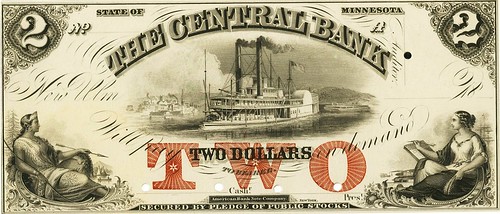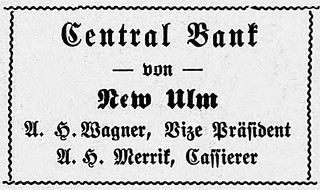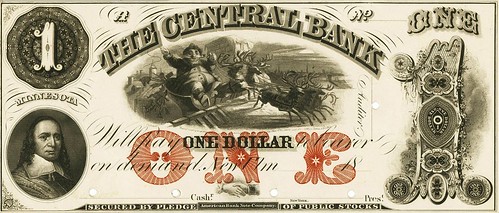
PREV ARTICLE
NEXT ARTICLE
FULL ISSUE
PREV FULL ISSUE
BANKNOTES OF NEW ULM, MINNESOTAIt's always nice to see mainstream publications discussing numismatic topics. The Journal of New Ulm, Minnesota just published a nice article on the obsolete banknotes of that town. Here's an excerpt - see the complete article online. -Editor
The Central Bank was organized in May 1859 by John W. North of Northfield, and Franklin Steele of Minneapolis. It is said that North and Steele were more interested in the bond markets, and were not actual bankers. They hired August H. Wagner, a well-known New Ulm citizen/merchant to serve as vice-president, and Albert H. Merrick (sp?), a bookkeeper in St. Paul, to serve as the cashier (see advertisement from New Ulm
The Knox brother had big plans for the New Ulm Central Bank, but the Civil War greatly pressured bonds of the northern states in the early summer of 1861. Banknotes suffered serious losses and forced the failure of banks nationwide. This was also the tipping point for free banking in Minnesota. Also, the hope that the Minnesota 7s would find their footing was extinguished. Henry and John J. Knox saw the writing on the wall and gave up their effort to issue more notes and supporting the circulation of the notes of the New Ulm Central Bank. The New Ulm Central Bank banknotes were presented for redemption, but the Knox brothers refused payment, and the state forced the bank into liquidation. The state auditor sold the bonds on deposit for a deep discount, leaving only enough hard money (silver/gold) to pay holders 30 cents on the dollar for the New Ulm Central Bank banknotes. The weight of the financial crisis forced the closure of the New Ulm Central Bank. According to the New Ulm Pioneer ( The banknotes issued by the New Ulm Central Bank were, like most banknotes of the time, beautifully ornate. All of the New Ulm Central Bank banknotes were printed by the American Bank Note Company who was a high security engraving and printing firm in the years prior to the Civil War. The company produced paper money, postage stamps, stock and bond certificates. All of the New Ulm Central Bank banknotes were only printed on one side, being blank on the back side, and only four denominations were issued: $1, $2, $5, and $10. The dimensions of these notes varied since they were cut down from sheets, but the average size was approximately 170mm x 71mm (6.7 inches x 2.8 inches). All of the banknote shown are examples of uncirculated, unsigned, and cancelled notes (as can be seen by the punch holes). Forgive me for the early Christmas reference. Heck, some stores around here have had Christmas decorations on sale since before Halloween. -Editor
ONE DOLLAR BANKNOTE:
To read the complete article, see:
Wayne Homren, Editor The Numismatic Bibliomania Society is a non-profit organization promoting numismatic literature. See our web site at coinbooks.org. To submit items for publication in The E-Sylum, write to the Editor at this address: whomren@gmail.com To subscribe go to: https://my.binhost.com/lists/listinfo/esylum All Rights Reserved. NBS Home Page Contact the NBS webmaster 
|



